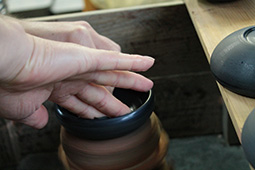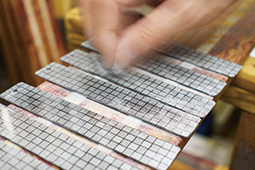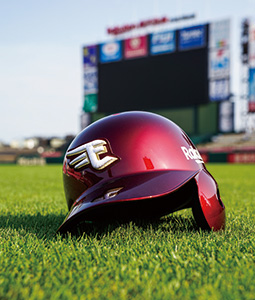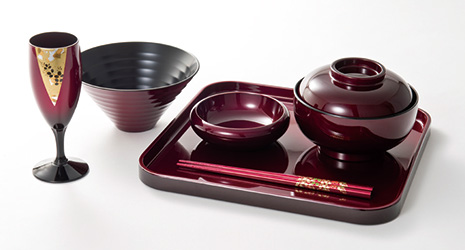INDEX

Lustrous Tamamushi lacquerware 
The base is created by polishing wood, metal, or other materials and is repeatedly painted with lacquer and polished 
Patterns are created in the final process and the item is finished 
The Sendai-based Tohoku Rakuten Golden Eagles baseball team uses helmets made with a Tamamushi lacquerware nanocomposite surface layer
January 2021
Lacquerware with a Sparkle that Lasts

Lacquerware, a traditional Japanese craft famous for its deep black color, has a surface that is predisposed to being easily scratched. Tamamushi lacquerware from Sendai City, Miyagi Prefecture, has overcome this weakness through technological developments, improving lacquerware’s durability and versatility.

Tamamushi lacquerware, a lacquering technique developed in Sendai City, Miyagi Prefecture, features a shiny luster that subtly changes depending on the angle of the light, just like the wings of the jewel beetle (tamamushi in Japanese) from which this technique takes its name. The history of this technique goes back to the National Research Institute of Industrial Arts (NRIIA), which was established in Sendai City by the government in 1928 with the aim of developing the industries of the Tohoku region through the development of craft products for export. As part of the initiatives there, research and development was carried out to make traditional lacquer work that would appeal to international markets, and experiments were carried out multiple times for all aspects, including color, design and texture. From this, there was an idea to use metal powder in lacquering, and in 1932, this came to fruition as Tamamushi lacquerware.
For Tamamushi lacquerware, the base is first created by polishing wood, metal, or other materials. Next, the base is painted with lacquer and polished, and this is repeated. Then, silver or aluminum powder is sprinkled on top of that, using the lacquer as an adhesive. Lacquer with added red, green or other colors of dye is then applied. Finally, patterns are created in the final process and the item is finished. In this way, Tamamushi lacquerware is created and the characteristic surface luster is formed through the reflection of light as it hits the sprinkled silver or aluminum powder.

Tohoku Kogei Co., Ltd. currently works with products that use the Tamamushi lacquerware technique. This company was established in 1933 with support from the NRIIA and Tohoku Imperial University (present-day Tohoku University). In 1939, the company was authorized to use the Tamamushi lacquerware patent held by the NRIIA, and they began commercializing Tamamushi lacquerware. Following the Second World War, the company then developed and sold coffee cups, salad bowls, flower vases, pencil cases, coasters, and other products aimed at both the Japanese and international markets. In 1985, these products received Miyagi Prefecture’s traditional crafts designation, and became known as a specialty product of Sendai.
A new turning point for Tamamushi lacquerware came in 2012.

Executive director Saura Midori says, “Tamamushi lacquerware dishes were displayed at one of the largest design festivals in Europe held in Germany and they were received well by many visitors, but we were asked by a buyer if they could be washed in a dishwasher. Lacquerware is easily scratched and can’t be washed in a dishwasher. To widely seek out international sales markets, including in countries where dishwashers are commonplace, there was a need to overcome this issue.”
What solved the problem was nanocomposite coating, a coating technology on the nano level (1 nanometer = 1 millionth of a millimeter). Tohoku Kogei and the National Institute of Advanced Industrial Science and Technology Tohoku jointly developed a hard resinous material by uniformly mixing clay and resin at the nano level. Products that are hard, difficult to scratch, and resistant to ultraviolet rays became possible by creating and overlaying a protective layer (the nanocomposite layer) on to Tamamushi lacquerware with this material.

According to Saura, “Development of this technology was a repetitive trial and error process. High precision technology was needed to thinly and uniformly spray the coating agent, and initially, there were problems with the coating becoming cloudy white or uneven textures occurring. Based on the coating process used by our veteran lacquer painter, we adjusted the viscosity of the coating agent, spray pressure, and the number of coatings, and established this technology over the course of about three years. I think that a meticulous coating technology was created based on our lengthy experience.”
The new Tamamushi lacquerware technology that was achieved in this way not only made the items resistant to scratches but also made it possible to apply to glass and porcelain. As a result, the company received the Sixth Monodzukuri Nippon Grand Award from the Minister of Economy, Trade and Industry in 2015 and their products were selected as gifts from Japan for the world leaders at the G7 Ise-Shima Summit in Japan. This technology also attracted the attention of the local Tohoku Rakuten Golden Eagles professional baseball team, and the technology has been applied to the coating of players’ helmets since the 2020 season.

Saura is placing high expectations on future potential, saying, “By having this technology used in helmets for baseball players proves that the technology stands up even to demanding uses, including against ultraviolet rays and impact. And I am thrilled that many people have experienced the charm of Tamamushi lacquerware through the sight of players moving around as the colors subtly change depending on the light. In the future, in addition to tableware which has been the main conventional application of lacquerware, I want to apply Tamamushi lacquerware to a wide range of uses, including cell phones and interior parts of cars.”
From seeds planted by the Japanese government some 90 years ago, private sector efforts have created a technology with a practicality and sparkle that will continue to be used and enjoyed long into the future.

